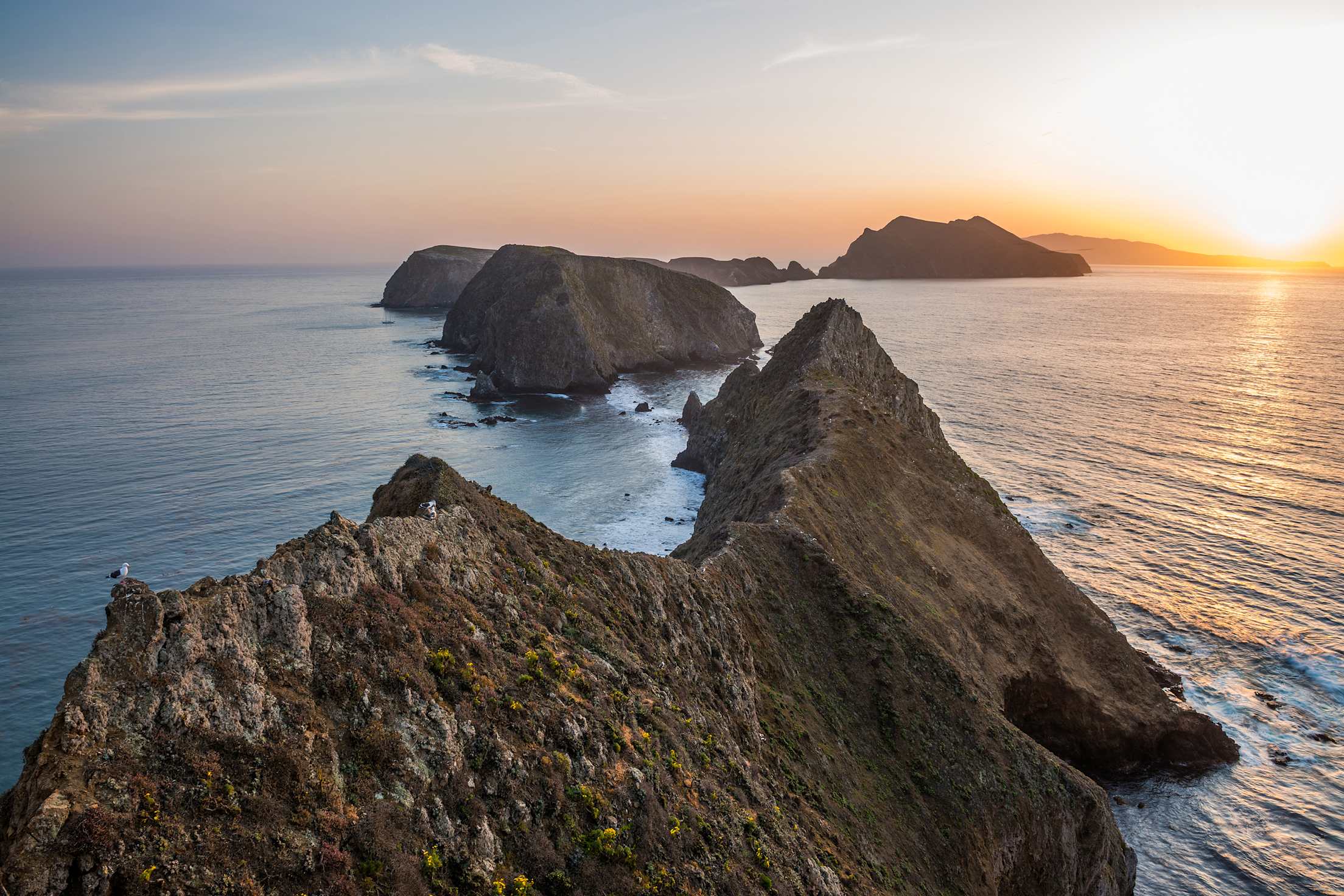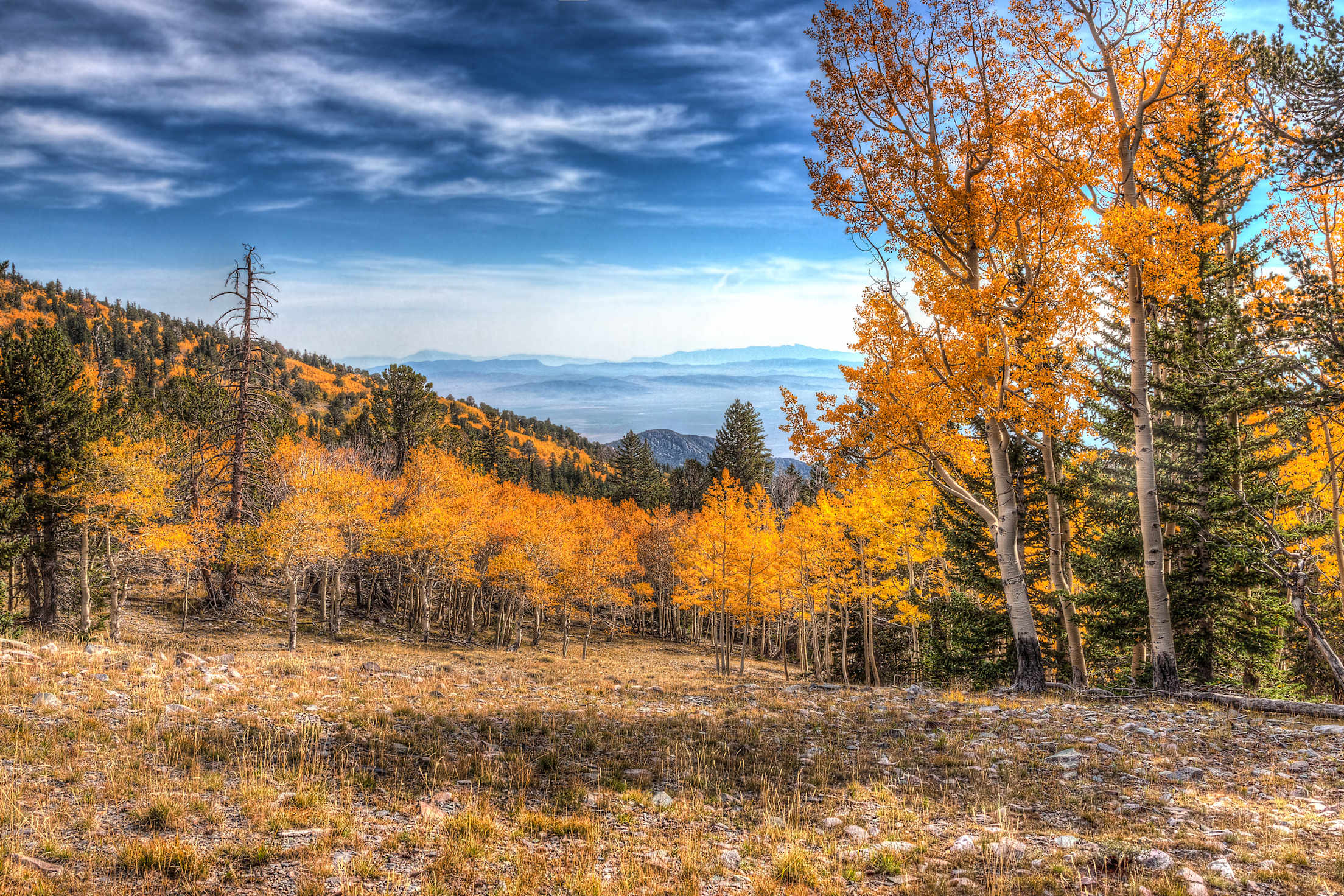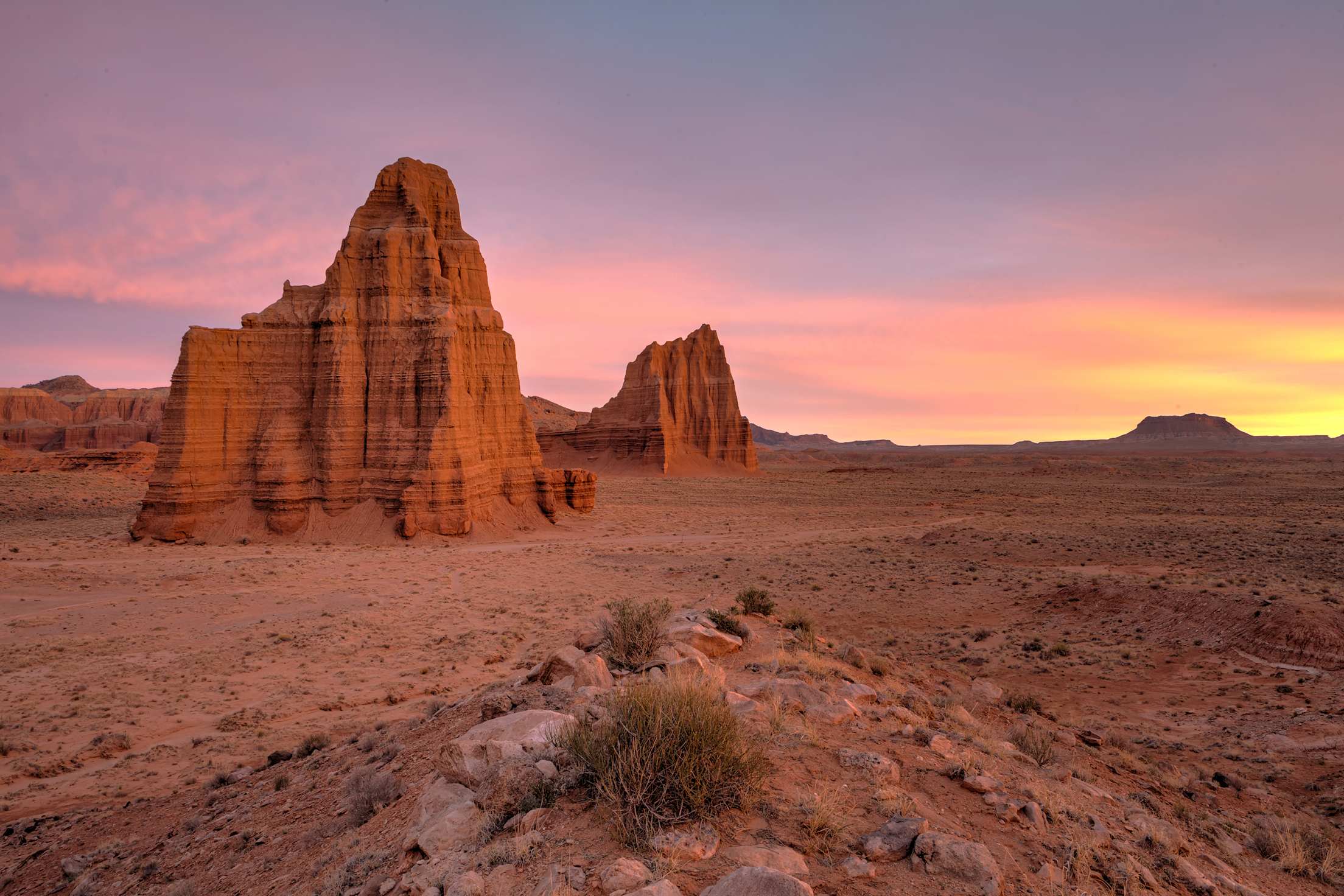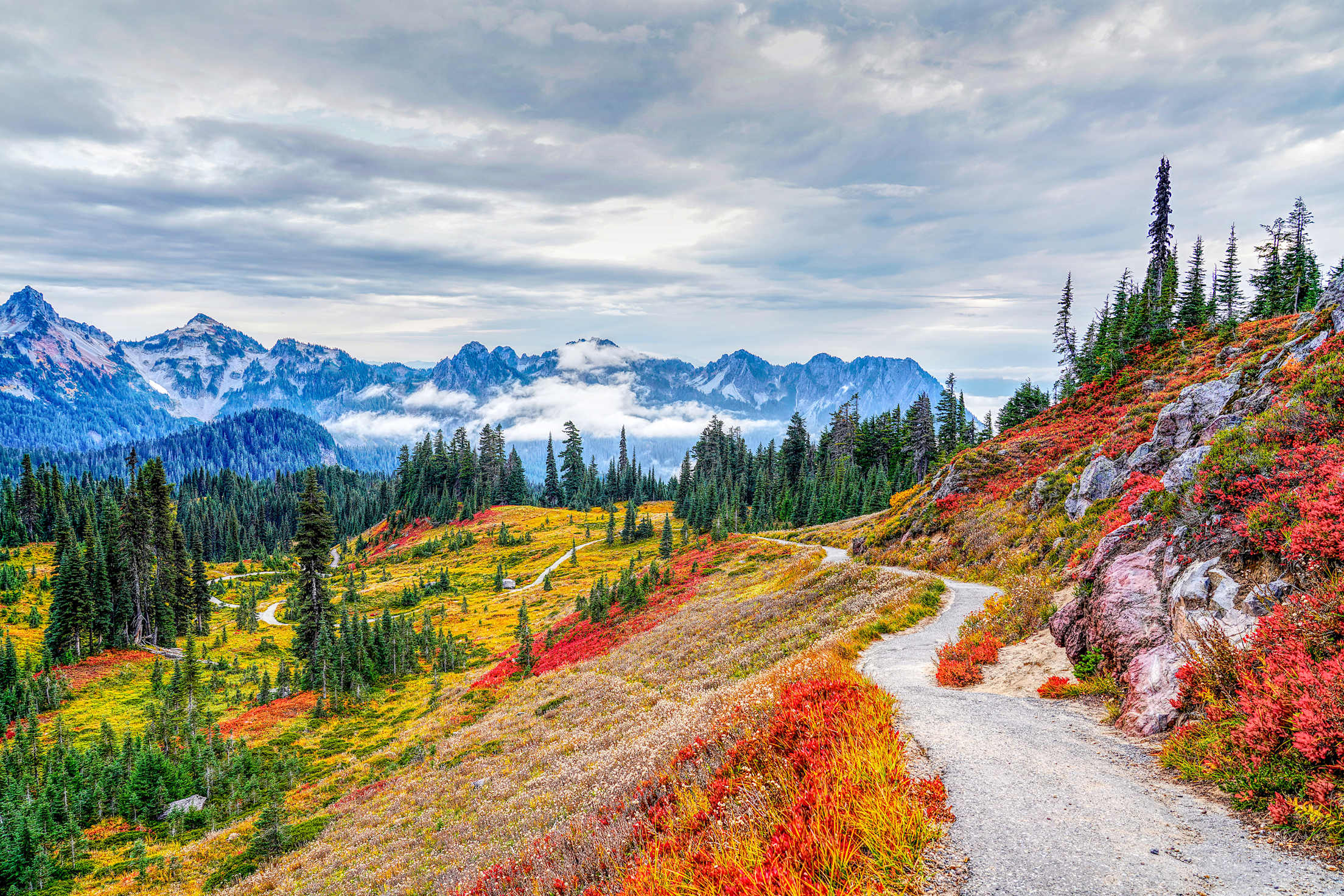
Best National Parks to Visit in the Fall
Enjoy shoulder season in the West’s great outdoors, from sunset-hued landscapes to hidden geysers.

As the mercury drops and folks head back to school and work, many national parks quiet down. Summer crowds thin and these hallowed places beckon with autumnal delights. Here are the West’s seven best parks to peep leaves, pick berries, gaze at the stars, and watch wildlife come fall.
Sequoia and Kings Canyon National Parks
Stunning Sierra scenery, a riot of colorful leaves, and a chance at snagging a parking spot to see it all? It sounds too good to be true. Ordinarily, Sequoia and Kings Canyon National Parks' stunning trees, which stretch up to 250 feet tall, hog the spotlight. But come September, the oaks, aspens, and cottonwoods make their own star turns. Drive General’s Highway for a bird’s-eye view of the foliage, stroll around Crescent Meadow to spot quaking golden aspen, or peep gold-hued cottonwoods and scarlet red dogwoods on the 7.8-mile Marble Falls Trail. The best part? Sequoia sees a fraction of the visitors Yosemite does in fall, meaning less time in line, no required reservation to get into the park, and more time peeping leaves. Stay abreast of the weather—and road closures, which begin in late October, or when snow arrives. As park lodges close for the season, check gateway communities, such as Visalia and Three Rivers, for more accommodation options.

Channel Islands National Park breaks free from the fog as summer recedes.
Channel Islands National Park
Come fall, something magical happens at Channel Islands National Park. After a summer often dominated by June gloom, the fog lifts and the islands emerge, visible from the mainland. Within the park, the sunshine makes it easier to spot some of the thousands of plant and animal species that earned the islands their nickname: the “Galapagos of the North.” A day here begins with the ferry ride and, with luck, you’ll spot wildlife immediately—whales on the horizon, dolphins splashing in the wake. Once you reach the islands, you might spy the adorable, endemic Channel Island fox, and the strikingly blue, remarkably smart island-scrub jay. But to tick the most species off your list, you’ll want to venture underwater, where kelp forests shelter 1,000 plants and animals. Fall is the best season to snorkel and scuba dive here, as the water is at its warmest (sometimes up to 70 degrees), and visibility can reach 100 feet. Look to Channel Island Adventure Co. for snorkel rentals and tours on Santa Cruz Island. Whether you’re exploring above or below the waves, be sure to reserve your ferry ticket in advance.

Changing leaves on Great Basin National Park's Wheeler Peak Summit Trail.
Great Basin National Park
When was the last time you saw the Milky Way splashed across the velvety night sky? If you’re like most of us (two-thirds of Americans), you can’t see our galaxy from your own backyard. Consider this your invitation to Great Basin National Park. Slung across the South Snake Mountains in the eastern Nevada desert, the park is high, dry, and remote: a trifecta that makes for exceptional stargazing. On clear, moonless nights here, thousands of stars are visible sans telescope. Conditions get even better in fall once summer monsoons end, making for clearer nighttime skies. To celebrate, the park mounts its Annual Astronomy Festival (September 22–14 this year). Festivities include guest speakers, a kid-friendly art project, and nightly stargazing parties, where visitors can take in the Milky Way, the Andromeda Galaxy, nebulae, and everything in between. Can’t make it then? Peruse the park’s website for ideas on where to stargaze on your own.

Temple of the Moon and Sun in Capitol Reef National Park.
Capitol Reef National Park
Visit Capitol Reef National Park at the right time, and you’ll find an especially sweet reward: fresh-off-the-tree peaches (late summer), pears, and apples. The glorious red rock park is home to Fruita, a town erected by enterprising Mormon pioneers in 1880. Fruita’s residents eventually moved on, but the orchards they planted persist: some 1,900 trees, now carefully preserved and tended by the National Park Service. Come August and September, the trees grow heavy with ripe peaches, pears, and apples, which visitors can pick for a small fee. The park provides ladders and fruit-picking equipment; just remember to bring your own bag. Complete your trip with a hike on the 2-mile Fremont River Trail, where the cottonwoods glow gold in the sun. Once night falls, the stars glow just as bright: like Great Basin, Capitol Reef is an International Dark Sky Park. This year, the park will host its Annual Heritage Starfest September 23–24.
Yellowstone National Park
Walking into Yellowstone National Park—with its erupting geysers, boiling mud pots, and psychedelic springs—feels like walking into a nature documentary; you almost expect a soundtrack. During the fall rutting season, you get one in the form of bull elk bugling loudly and, occasionally, crashing antlers to battle over mates. The bears, too, are especially active in fall, engaged in a frenzied state of hyperphagia: eating and drinking practically nonstop to prepare for hibernation. For the best chance to see—and hear—elk, visit Mammoth Hot Springs and the Madison River; to spot bears, check the roadside meadows. Remember to give all animals a wide berth—a minimum of 100 yards for bears and wolves, 25 yards for everything else, including bison and elk. And if you want to watch geysers without the Old Faithful crowds, hike the nine miles to Shoshone Basin, the park’s largest backcountry geyser basin. Given Yellowstone’s popularity, park lodging books out well in advance; for more lodging availability, consider towns outside the park, such as Afton, Cody, and Dubois in Wyoming, and Gardiner* and Livingston* in Montana. Check weather forecasts and road closures before arriving. *Editor's note: the North and Northeast Entrances into Yellowstone are closed to visitor vehicles, but they can still be accessed through an approved tour group or by biking or walking into the park.
Smart Tip: If you have time, take a drive into Grand Teton National Park to see yellowed aspens against the jagged peaks and vibrant blue skies. Listen for elk bugles as you take in the views.

Berries turn brilliant red in Mt. Rainier National Park.
Mount Rainier National Park
When it comes to fall color, Mount Rainier National Park lands on many best lists—and for good reason. As the weather cools, the park’s profusion of huckleberry bushes turn a shade of scarlet that would make Hester Prynne blush, a stark contrast to the deep greens and blues surrounding them. For panoramic views of this display, drive Stevens Canyon Road (closed Monday thorugh Thursday from Stevens Creek to Box Canyon through September 29), where flaming huckleberry bushes fill the avalanche shoots. To see the colors up close, hike the 3.5-mile Naches Peak Loop Trail, where the crimson bushes frame views of Rainier itself. Another seasonal bonus? Park visitors can pick the huckleberries; each person may harvest up to 1 gallon daily. Just make sure to stay on the trail. If you can—and you’re prepared for high-elevation temperatures—spend the night at White River Campground. The 88 first-come, first-serve sites are located in a glacial canyon so beautiful you’ll be tempted to launch into a Sound of Music medley. The campground typically closes in late September or early October with the first snowfall. Be sure to check road and weather conditions before arriving.
Petrified Forest National Park
Autumn is Goldilocks season at Petrified Forest National Park: The heat has faded, but it isn’t yet cold at night. The wild grasses are still green from summer monsoons, yet the cottonwoods are starting to turn. Stroll along the Puerco River near Puerco Pueblo to see these beauties in their golden glory; look closely at the branches, and you might spy a porcupine posing as a tumbleweed. The season offers perfect camping weather and, for backcountry campers, Petrified Forest is a dream come true: You can pick up a free permit the day you’d like to camp, then blaze your own trail through 50,000 acres of wilderness. Out there, it’s just you, the badlands, and the hoodoos. As Sarah Herve, the park’s Public Information Officer, puts it, the park is amazing because, “it’s incredibly quiet—pin-drop kind of quiet—and you’re hiking among these beautiful reddish and purplish rocks.”